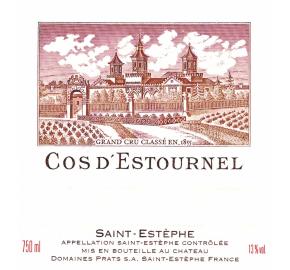
Chateau Cos d'Estournel 2012
- Producer Chateau Cos d'Estournel
-
Blend
2% Cabernet Franc
75% Cabernet Sauvignon
22% Merlot
1% Petite Verdot - Country France
- Region Bordeaux
- Appellation Saint-Estephe
- UPC 0 15643 42699 5
Log in to view pricing and order online
Don't have an account? Register here
Item# 1650-12
James Suckling
95pt
Wine Enthusiast
94pt
Wine Spectator
92pt
Wine Advocate
93+pt
Background
The grapes were small with thin yet robust skins. A rapid extraction of anthocyanins was noted during the pre-fermentation macerations.
The use of the gravity proved to be even more useful this year for the merlots with a high tannic potential. It also enabled better control of components of the musts due to much gentler extractions, producing smoother tannins, while at the same time preserving the vintage’s freshness and fruity character.
The use of the gravity proved to be even more useful this year for the merlots with a high tannic potential. It also enabled better control of components of the musts due to much gentler extractions, producing smoother tannins, while at the same time preserving the vintage’s freshness and fruity character.
Vintage
The winter of 2011-2012 saw a severe lack of rainfall and ended with mild weather with the first buds already on the vines. This mildness did not last long and temperatures were cool in the Bordeaux region from April onwards. It was far too early to be making any predictions, but this changeable spring weather had the effect of slowing down growth and causing an uneven bud break. The start of flowering was late. Mid-flowering was recorded on 12 June in Cos d'Estournel's vineyard.
From mid-July there was a dramatic change in the weather. As the old saying goes, c'est aout qui fait le mout ("August makes the must")!
August2012 will be remembered as being the hottest August since 2003, and also as being drier than the summer of 2010. Temperatures were particularly high during the second half of August. In Cos d'Estournel's vineyards. We observed that despite a wet spring, there was a marked shortage of rain during the summer at Cos d'Estournel. However, our vineyard was able to cope very well with this situation as it enjoys a temperate, well-ventilated microclimate due to the proximity of the Atlantic Ocean and its position on the edge of a plateau. The water stress during the summer of 2012 was accompanied by a substantial variation between day and night temperatures (around 13° between 15 August and 15 September), without excessively high temperatures when the grapes were ripening. To some extent this was reminiscent of 2010. These conditions were very favourable for the synthesis of anthocyanins and the preservation of aromatic freshness. They also enabled the vines to do some catching up after the late flowering. Regular and intensified work of the soil on the high quality plots, the natural balance of the vines' vigour, and enhanced management of cover crop have enabled Cos d'Estournel's vines to be more resistant to extreme weather conditions due to a more developed root system. Our clay subsoil also played an important role as a "reservoir" of coolness and moisture. Cos d'Estournel's old vines did particularly well this year. Their deep roots enabled them to flourish without any checks during ripening.
August2012 will be remembered as being the hottest August since 2003, and also as being drier than the summer of 2010. Temperatures were particularly high during the second half of August. In Cos d'Estournel's vineyards. We observed that despite a wet spring, there was a marked shortage of rain during the summer at Cos d'Estournel. However, our vineyard was able to cope very well with this situation as it enjoys a temperate, well-ventilated microclimate due to the proximity of the Atlantic Ocean and its position on the edge of a plateau. The water stress during the summer of 2012 was accompanied by a substantial variation between day and night temperatures (around 13° between 15 August and 15 September), without excessively high temperatures when the grapes were ripening. To some extent this was reminiscent of 2010. These conditions were very favourable for the synthesis of anthocyanins and the preservation of aromatic freshness. They also enabled the vines to do some catching up after the late flowering. Regular and intensified work of the soil on the high quality plots, the natural balance of the vines' vigour, and enhanced management of cover crop have enabled Cos d'Estournel's vines to be more resistant to extreme weather conditions due to a more developed root system. Our clay subsoil also played an important role as a "reservoir" of coolness and moisture. Cos d'Estournel's old vines did particularly well this year. Their deep roots enabled them to flourish without any checks during ripening.
Harvest
Conditions for the harvests were excellent, and the water stress during the ripening period resulted in a good development of phenolic compounds. It was also the reason of the small size of the grapes. The disruption of the flowering ended up being an advantage. It meant that the grapes were relatively loosely spaced on the bunches, and therefore well-ventilated, and with low yields.
The rain in September prevented any checks in the ripening process and enabled us to obtain a perfect synchronisation between the phenolic ripeness and the balance of acidity/potential alcohol. It should also be noted that these were the longest harvests in the last thirteen years, due to the substantial differences in the ripening of the Grands Merlots and the Grands Cabernets. The weather conditions for the harvests combined with careful management of the vineyard and low yields enabled us to obtain optimal degrees of ripeness.
The rain in September prevented any checks in the ripening process and enabled us to obtain a perfect synchronisation between the phenolic ripeness and the balance of acidity/potential alcohol. It should also be noted that these were the longest harvests in the last thirteen years, due to the substantial differences in the ripening of the Grands Merlots and the Grands Cabernets. The weather conditions for the harvests combined with careful management of the vineyard and low yields enabled us to obtain optimal degrees of ripeness.
